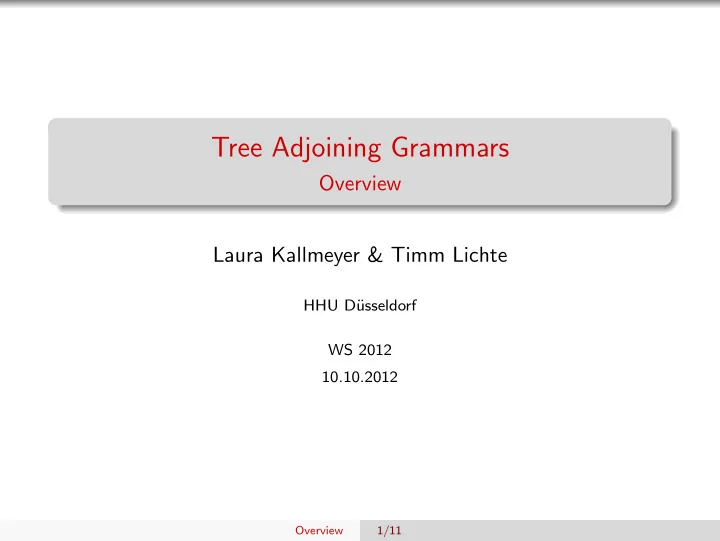

Tree Adjoining Grammars Overview Laura Kallmeyer & Timm Lichte HHU D¨ usseldorf WS 2012 10.10.2012 Overview 1/11
The general setting Grammar formalism: Grammar/ linguistic theory: mathmatically concise description language rules for well-formed structures of natural Tree Adjoining Grammar (TAG) language Implementation: (the result of) a process to translate sth. into a specific grammar formalism into a specific input format for a parser into . . . Overview 2/11
Two meanings of “implementation” grammar/ linguistic theory “implementation” specifications in accordance with a grammar formalism evaluation of the theory As is frequently pointed out but cannot be overemphasized, an important goal of formalization in linguistics is to enable subsequent researchers to see the defects of an analysis as clearly as its merits ; only then can progress be made efficiently. (Dowty, 1979, 322) Overview 3/11
Two meanings of “implementation” grammar/ linguistic theory “implementation” specifications in accordance with a grammar formalism “implementation” evaluation grammar resource of the theory computational application Overview 4/11
The landscape of Grammar Formalisms (1) generative rewriting formalisms: Context-Free Grammar (CFG) Tree-Adjoining Grammar (TAG) Lexical Functional Grammar (LFG) Transformational Grammar (TG/GB), Minimalism proof-theoretic formalisms: Combinatorial Categorial Grammar (CCG) model-theoretic/constraint-based formalisms: Head-Driven Phrase Structure Grammar (HPSG) Overview 5/11
The landscape of Grammar Formalisms (2) Within Chomsky hierarchy : ✬ ✩ ✬ ✩ ✬ ✩ ★ ✥ ✎ ☞ type 3 / regular ✍ ✌ FSA type 2 / context-free ✧ ✦ CFG mildly context-sensitive ✫ ✪ TAG, CCG, Minimalist Grammar ✫ ✪ type 1 / context-sensitive type 0 / recursively enumerable (or beyond) ✫ ✪ HPSG, LFG, TG Overview 6/11
Tree-Adjoining Grammar - Basics A Tree Adjoining Grammar (TAG) is a set of elementary trees: a finite set of initial trees a finite set of auxiliary trees VP VP NP ↓ VP E.g.: ADV VP* V NP ↓ easily repaired Combinatorial operations: substitution: replacing a non-terminal leaf with an initial tree adjunction: replacing an internal node with an auxiliary tree Overview 7/11
Tree-Adjoining Grammar - Example VP NP NP ↓ VP NP Peter V NP ↓ the fridge VP repaired ADV VP* easily derived tree derivation tree VP NP VP ADV VP Peter repaired easily V NP 1 2 22 repaired the fridge easily the fridge Peter Overview 8/11
Tree-Adjoining Grammar - Basics TAGs are mildly context-sensitive: 1) Polynomial time parsing complexity 2) Generation of limited crossing dependencies 3) Constant growth property (semilinearity) Mild context-sensitivity characterizes the generative capacity needed for the analysis of natural language syntax. Large TAG grammars: English and Korean (XTAG, UPenn) French TAG (Benoit Crabb´ e’s PhD-thesis) German (GerTT) . . . Overview 9/11
Two ways of grammar implementation with TAG 1) XTAG tools (UPenn) parser, editor, viewer, . . . 2) XMG + TuLiPA XMG: eXtensible MetaGrammar (Duchier et al, 2004) TuLiPA: T¨ ubingen Linguistic Parsing Architecture (Parmentier et al, 2008) Overview 10/11
Inside and outside this lecture What we are going to cover: 1. Grammar formalism: Tree Adjoining Grammar (TAG) 2. Phenomena + analysis from the XTAG grammar (syntax, few semantics) 3. Implementation: XTAG tools, XMG + TuLiPA What is not part of our concerns in this lecture: pragmatics, morphology, phonetics/phonology , . . . Head Driven Phrase Structure Grammar (HPSG), Combinatorial Categorial Grammar (CCG), Lexical Functional Grammar (LFG), Transformational Grammar (GB), Minimalism corpus-driven approaches (quantitative linguistics) Overview 11/11
Recommend
More recommend